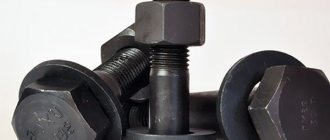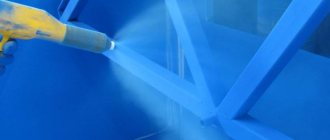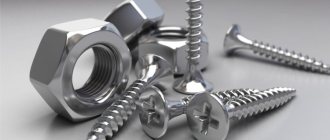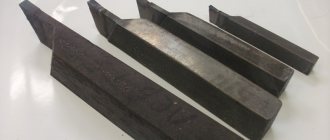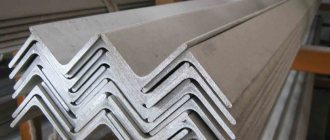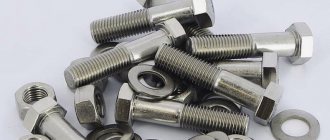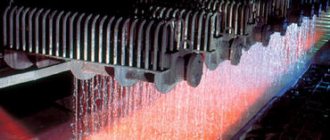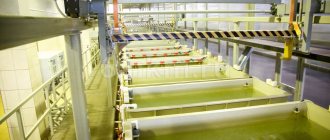Chemical oxidation by oiling is one of many technologies for processing metals and alloys, which can improve its physical properties. In addition, the appearance of the part changes: it acquires a dark color, due to which the technology is also called “blackening”. If you need chemical oks.prm galvanic coating services, contact the Metallocenter manufacturing enterprise. We will ensure timely order fulfillment and convenient delivery of finished products.
How is chemical oxidation by oiling performed?
Like other processing methods, this process involves the deliberate oxidation of the surface layer of products in special solutions. Oxidation takes place in several stages, the first of which is cleaning and degreasing the parts. It includes chemical processing, hot and cold washing, etching.
The next stage is the actual oxidation. At this stage, the processed and sorted parts are immersed in a special bath filled with a solution consisting of a concentrated alkaline solution, iron and water. Throughout this stage, a certain temperature is maintained. After this, repeated washing and drying occurs.
The final stage is the impregnation of dry parts with industrial oil. This process is crucial, since without it the surface will be highly porous and will not be able to provide the required level of protection.
Chemical ox.prm galvanic coating can be used for almost all types of metal products. The most frequently processed are:
- hardware;
- fasteners;
- rigging;
- hardware;
- Assembly units;
- bar parts and so on.
Blueing is often used to improve the appearance of decorative elements. As a result of applying an additional protective coating, the surface of the part acquires a deep dark color that does not glare.
Advantages of chemical oxidation by oiling
Chemical ox.prm galvanic coating improves the physical properties of products:
- Makes them more resistant to corrosion.
- Increases the adhesion of paints and varnishes.
- Increases wear resistance.
- The black coating does not produce glare.
- The appearance of the product improves.
In this case, the additional layer resulting from processing does not change the appearance and dimensions of the part.
Important!
After bluing, the product cannot be soldered or welded.
As a separate advantage, we can note the affordable cost of chemical oxidation by oiling.
Main characteristics of coatings
Zinc coating
1
.
The zinc coating is anodic in relation to ferrous metals and protects steel from corrosion electrochemically at temperatures up to 70 °C, and mechanically at higher temperatures. The coating prevents contact corrosion of steels when mating with parts made of aluminum and its alloys; ensures screwability of threaded parts. 2
.
To increase corrosion resistance, the zinc coating is chromated and phosphated. Chromating simultaneously improves the decorative appearance of the coating. Chromate film is mechanically fragile. 3
.
Chromated zinc coating loses its decorative appearance under the condition of periodic mechanical impact: touch of a tool, hands. 4
.
Without chromating and phosphating, the coating is used to ensure electrical conductivity even when crimping with plastics at temperatures above 100 °C. 5
.
Electrochemical galvanizing causes a loss of steel ductility due to hydrogenation. Steels with a tensile strength higher than 1380 MPa cannot be galvanized. 6
.
The coating has strong adhesion to the base metal, low resistance to mechanical abrasion and increased fragility at temperatures above 250 °C and below minus 70 °C; The matte coating withstands bending and flaring. The coating has low chemical resistance to the effects of products released during the aging of organic materials. 7
. The microhardness of the coating applied by electrochemical method is, on average, 490-1180 MPa (50-120 kgf/mm2); specific resistance: at a temperature of 18 °C is 5.75-10-8 Ohm-m.
Cadmium coating
1
.
The cadmium coating is anodic and protects steel from corrosion in the atmosphere and seawater electrochemically; in fresh water - mechanically. 2
.
To increase corrosion resistance, the cadmium coating is chromated and phosphated. Chromating simultaneously improves the decorative appearance of the coating. Chromate film is mechanically fragile. The corrosion rate in an industrial atmosphere is 1.5-2 times higher than that of zinc coating. 3
.
Without chromating and phosphating, the coating is used to ensure electrical conductivity when crimping with plastics at temperatures above 100 °C. 4
.
The coating is not recommended for use in parts operating in industrial atmospheres; in contact with fuel containing sulfur compounds; in an atmosphere containing volatile aggressive compounds released from organic substances during aging: when drying drying oil, oil varnishes, etc. 5
.
Electrochemical cadmium plating causes a loss of steel ductility due to hydrogenation. For parts made of steel with a tensile strength above 1370 MPa (140 kgf/mm2), cadmium plating using a special technology is allowed. 6
.
The coating has strong adhesion to the base metal, good anti-friction properties, and low wear resistance; more ductile than zinc; withstands pressing, drawing, flaring, screwing. Cadmium oxides are toxic. Welding on cadmium coating is not allowed. 7
. Microhardness of cadmium coating is 340-490 MPa (35-50 kgf/mm2); resistivity at a temperature of 18 °C - 10.98-10-8 Ohm-m.
Nickel plating
1
.
Nickel coating is cathodic to steel, aluminum and zinc alloys. The coating is used for protective, protective and decorative finishing of parts, increasing surface hardness, wear resistance and electrical conductivity. 2
.
To increase the decorative effect of the coating, chromium up to 1 micron thick is applied to the nickel sublayer. 3
.
Increased corrosion resistance is achieved by combining several layers of nickel coatings with different physical and chemical properties. With a thickness of 24 microns, the protective properties of a two-layer coating (without a copper sublayer) are two times higher, and a three-layer coating with filler is three times higher than the protective properties of shiny coatings. 4
.
Specific resistance at a temperature of 18 °C - 7.23-10-8 Ohm-m; microhardness of the shiny coating - 4420-4900, semi-shiny - 2940-3930 MPa; The reflectance of the shiny coating is 75%. Permissible operating temperature 650 °C. 5
.
The coating ensures good spreadability of solders and the production of vacuum-tight joints during high-temperature soldering in various environments without the use of fluxes, as well as during argon arc welding (in the latter case, without a copper sublayer). Nickel coating up to 6 microns thick can be spot welded. 6
.
The coating serves as a barrier layer against gold, silver, tin-lead and other metals, preventing the diffusion of copper, zinc, iron and other metals. 7
. Black nickel coating is used to give parts special optical and decorative properties. Reflection coefficient of black nickel coating is up to 20%.
Nickel chemical plating
1
.
Electrochemical nickel coating containing 3-12% phosphorus has better protective properties compared to electrochemical nickel coating. The coating has increased hardness and wear resistance and is recommended for parts operating under friction conditions, especially in the absence of lubrication; used for corrosion protection and for soldering with low-temperature solders. The coating is highly brittle; bending and flaring of parts with chemical nickel coating is not recommended. 2
.
The coating is recommended to be used primarily for complexly profiled parts. 3
.
After heat treatment at a temperature of 400 °C, the coating acquires high hardness. 4
. The microhardness of the coating after heat treatment is 6400-11800 MPa (650-1200 kgf/mm2); resistivity at a temperature of 18 °C - 6.8-10-7 Ohm-m
Chrome plating
1
.
Chrome coating is cathodic to steel, aluminum and zinc alloys, provides corrosion protection and improves decorative appearance. 2
.
The protective and decorative coating is applied over the nickel sublayer with a thin mirror-shiny layer up to 1 micron. A coating up to 0.5 microns thick is porous; as the thickness increases, a network of cracks is formed. 3.
Electrochemical chrome coating can be hard, porous, milky.
4
.
Hard chrome coating has high wear resistance, heat resistance, low friction coefficient, poor wettability, and low ductility. The coating works effectively against friction (when applied to a solid base), withstands a uniformly distributed load, and is easily destroyed under the influence of concentrated impact loads. 5
.
Milky chrome coating has low hardness and wear resistance, and low porosity. The coating protects against corrosion while maintaining its decorative appearance. 6
.
Hydrogenation of steels is stronger when obtaining a milky coating than a hard coating. 7
.
For parts that require corrosion protection, decorative finishing, and wear resistance, it is recommended to use a combined coating consisting of milk and hard chrome. 8
.
The porous coating increases the wear resistance of parts. The coating is characterized by a branched network of cracks (the pores are expanded by additional anodic etching). 9
.
Black chrome plating is used to create a light-absorbing surface; The coating is not durable when exposed to friction. Reflection coefficient of black chrome coating is 3-4%; the coating is stable in vacuum. 10
.
The application of chromium coatings to complexly profiled parts is difficult due to the low dissipative ability of chromium electrolytes. eleven
.
To increase corrosion resistance, chrome-plated parts can be subjected to additional processing (hydrophobization, impregnation, etc.). When operating in conditions of direct exposure to sea water, periodic re-lubrication is recommended for additional protection of chrome-plated parts. 12
. The microhardness of hard chrome coating is 7350-10780 MPa (750-1100 kgf/mm2), black chrome coating -2940-3430 MPa (300-350 kgf/mm2).
Copper plating
1
.
Copper coating is cathodic to steel, aluminum, magnesium and zinc alloys. The coating is used as a technological sublayer to reduce porosity and increase the adhesion of other coatings. It is not recommended as a stand-alone coating for corrosion protection due to low corrosion resistance. 2
.
Copper coating has high electrical and thermal conductivity, ductility, withstands deep drawing, flaring, is well polished, facilitates running-in, lapping and screwing; in a freshly deposited state it solders well. With low-temperature solders it forms intermetallic compounds, which sharply worsen the solderability and strength of the soldered joint. 3
. The permissible operating temperature of the coating is 300 °C; coating microhardness -590-1470 MPa (60-150 kgf/mm2); resistivity at a temperature of 18 °C - 1.68 10-8 Ohm-m.
Copper-tin alloy coating
1
.
The coating with a high-tin alloy M-O(60) is cathodic in relation to steel; it is recommended to increase the wear resistance of electrical contact parts, as well as to ensure soldering. The coating can be used as a protective and decorative coating. 2
.
The coating is resistant to alkalis, weak organic acids and sulfur compounds. 3
.
The reflectivity of the coating is 60-65%, wear resistance is 4 times greater than that of silver coating; hardness is 5-6 times greater than the hardness of copper coating. 4
.
The coating is easily soldered with low-temperature solders using rosin fluxes. 5
.
The coating is not subject to the growth of whiskers and transition to powder modification at low temperatures. 6
. The microhardness of the coating is 5390-6370 MPa (550-650 kgf/mm2).
Tin coating
1
.
Tin coating in atmospheric conditions is cathodic in relation to steel, anodic in many organic environments, as well as in relation to copper and its alloys containing more than 50% copper. The coating is recommended for solderability. 2
.
Tin coating is resistant to sulfur-containing compounds and is recommended for parts in contact with all types of plastics and rubbers. 3
.
The tin coating has good adhesion to the base metal, elasticity, withstands bending, drawing, flaring, stamping, press fit, and is well preserved when screwed together. Freshly deposited tin coating is easily soldered. A shiny coating retains solderability for a longer time than a matte coating. 4
.
Matte tin coating is characterized by significant porosity. The porosity of thin coatings (up to 6 microns) can be reduced by melting the coating or applying a shiny coating. 5
.
Wire-like conductive crystals (“needles”) are formed on the surface of the coating during storage. 6
.
When tin coatings are used at temperatures below plus 13 °C, destruction of the coating is possible due to the transition of compact white tin (b-Sn) to powdery gray tin (a-Sn) (“tin plague”). 7
. Coating microhardness - 118-198 MPa (12-20 kgf/mm2); resistivity at 18 °C - 11.5-10-8 Ohm-m. The permissible operating temperature of the coating is 200 °C.
Tin-nickel alloy coating
1
.
The O-H(65) alloy coating is cathodic with respect to steel; recommended as a protective agent for parts to be soldered; to ensure surface hardness and wear resistance. 2
.
The coating has high corrosion resistance: it is resistant to conditions of high humidity and environments containing sulfur compounds. 3
.
The coating is highly polished and can withstand pressing into plastics; due to its high fragility, it is not recommended for parts subject to flaring and impact loads. 4
. Microhardness of the coating is 4900-5880 MPa (500-600 kgf/mm2). Permissible operating temperature is 300-350 °C.
Tin-bismuth alloy coating
1
.
The coating with the 0-Bi-(99.8) alloy under atmospheric conditions is cathodic in relation to steel, anodic in relation to copper and its alloys containing more than 50% copper; recommended as a protective agent for parts to be soldered. 2
.
Corrosion resistance and pinning tendency are the same as tin coating. 3
. The coating withstands flaring, stamping, press fits well, and is preserved during screwing.
Tin-lead alloy coating
1
.
The O-C(60) alloy coating under atmospheric conditions is cathodic in relation to steel, and anodic in relation to copper and its alloys. The coating ensures solderability with low-temperature solders. 2
.
In conditions of high temperature and humidity, the corrosion resistance is lower than that of tin coating. 3
.
The coating is plastic, has low electrical resistance, and is soldered using non-activated rosin fluxes. 4
.
The fused coating has better performance characteristics. 5
.
The melted coating is not subject to needle formation. On zinc-containing alloys, the coating should be applied over a nickel sublayer, which prevents the diffusion of zinc into the coating and needle formation. 6
. The solderability of the coating after crimping into polymer materials, if necessary, is restored using a hot method with non-activated rosin flux.
Gold plating
1
.
Gold coating is cathodic in relation to the metals being coated and protects them mechanically; recommended to ensure low and stable transient electrical resistance of contacting surfaces, improving surface electrical conductivity. 2
.
The coating has high thermal and electrical conductivity, chemical resistance, including in an atmosphere with high humidity and sulfur-containing environments. 3
.
Group contacts coated with gold and gold alloys, which usually have small gaps between the circuits, for operating conditions 4-8 should be sealed or placed in dust-splash-proof devices. 4
.
Coatings of cyanide electrolytes used in contact devices tend to increase the adhesion of rubbing surfaces during operation. A coating made of acidic electrolytes does not have such a defect. 5
.
When depositing gold plating on brass, an underlayer of nickel is recommended to prevent the diffusion of zinc onto the surface of the gold platings from the base metal. The nickel sublayer under coating with gold and gold alloys should be applied from electrolytes that provide a coating with low internal stresses. 6
.
With tin-lead solders, gold plating forms brittle intermetallic compounds that reduce the mechanical strength of the solder joint. 7
. Coating microhardness 392-980 MPa (40-100 kgf/mm2); resistivity at a temperature of 18 °C - 2.2-10-8 Ohm-m; internal stresses reach 59-147 MPa (6-15 kgf/mm2).
Gold-nickel alloy plating
1.
Coatings with alloys Zl-N (99.5-99.9), Zl-N (98.5-99.5), Zl-N (93.0-95.0) are cathodic in relation to the metals being coated and protect them mechanically.
The corrosion resistance of gold-nickel alloy and functional purpose are the same as gold plating. 2
.
The coating is characterized by high electrical and thermal conductivity, high hardness, increased wear resistance, lack of tendency to weld, and low internal stresses; It is characterized by chemical resistance in various aggressive environments and retains its characteristics stable over time. 3
.
The nickel sublayer creates favorable operating conditions for friction coatings, prevents diffusion of the base metal at temperatures up to 350 °C, and promotes the stability of contact resistance. 4
. With tin-lead solders, the coating forms brittle intermetallic compounds, which reduce the mechanical strength of the solder joint.
Silver plating
1
.
Silver coating is cathodic in relation to the metals being coated; recommended to ensure low contact resistance, to improve surface electrical conductivity. 2
.
The coating is characterized by high electrical and thermal conductivity, plasticity, and reflectivity; low hardness, resistance to mechanical wear and internal stresses; tendency to weld. The coating withstands bending and flaring well, but does not tolerate crimping into polymer materials. The coating is subject to migration along the dielectric surface under the influence of potential differences. Gloss formers in coating electrolytes can negatively affect the electrical conductivity of the coating. 3
.
It is not allowed to use silver coating as a sublayer under gold due to the diffusion of silver through gold with the formation of surface non-conducting films (When using products with electrical contacts with gold coating on the silver sublayer, instability of the contact resistance is possible up to failure due to the diffusion of silver through gold). 4
.
Under the influence of chlorine compounds, ammonia, sulfur-containing, phenol-containing, etc. substances, a film is formed on the surface of silver and silver-containing coatings, which increases the contact resistance of the coating and makes it difficult to solder. 5
. Coating microhardness - 883-1370 MPa (90-140 kgf/mm2), which over time can decrease to 558 MPa (60 kgf/mm2); resistivity at a temperature of 18 °C - 1.6-10-8 Ohm-m .
Palladium plating
1
.
Palladium coating is cathodic in relation to the metals being coated and is highly resistant to atmospheric conditions and exposure to sulfur compounds. 2
.
The coating is recommended to be used to reduce the transition resistance of contacting surfaces, increase their surface hardness and wear resistance, if necessary, maintaining a constant electrical resistance. 3
.
The coating has high wear resistance and good electrical conductivity, stable contact resistance over time; reflection coefficient - 60-70% Electrical conductivity is almost seven times lower than that of a silver coating, but is stable over time up to a temperature of 300 ° C. 4
.
The coating is not recommended for use in contact with organic materials and rubbers, as well as in a confined space in the presence of these materials; It is not allowed to be used in a hydrogen environment. 5
.
When the thickness is more than 9 microns, microcracks appear in the coating, which reduces its functional and protective properties. 6
. Coating microhardness - 1960-2450 MPa (200-260 kgf/mm2); resistivity at a temperature of 18 °C - 10.8-10-8 Ohm-m; internal stresses reach 686 MPa (70 kgf/mm2).
Rhodium plated
1
.
Rhodium coating is cathodic in relation to the metals being coated. 2
.
The coating is recommended to be used to ensure stable electrical parameters of parts of contact devices and increase the reflectivity of the surface. 3
.
The coating has high wear resistance, electrical conductivity, and reflectivity. Reflection coefficient - 76-81%. The coating is not subject to welding, is resistant to most corrosive environments, including hydrogen sulfide, and does not oxidize up to a temperature of 500 °C. 4
.
A coating with a thickness of 1.0 microns has practically no pores; with a thickness of more than 3 microns, it is prone to the formation of microcracks. 5
. Coating microhardness - 3920-7840 MPa (400-800 kgf/mm2); resistivity at a temperature of 18 °C - 4.5-10-8 Ohm-m; internal stresses reach 1670 MPa (170 kgf/mm2).
Anodic oxide coatings
1
.
For aluminum and aluminum alloys 1.1
.
When anodizing, the dimensions of the parts increase by approximately 0.5 of the coating thickness (per side). 1.2
.
The quality of the anodic oxide coating increases with the improvement of the surface finish of the parts. 1.3
.
Anodic oxide coatings used for corrosion protection are filled in a solution of potassium dichromate, sodium dichromate or in water, depending on their purpose. These coatings are a good basis for applying paints, adhesives, sealants, etc. To give parts a decorative appearance, anodic oxide coatings are painted before filling by the adsorption method in solutions of various dyes or electrochemically in solutions of metal salts. 1.4
.
To obtain a mirror-like shine on anodized parts made of aluminum alloys, it is recommended to pre-polish the surface. The reflectivity of anodized aluminum and its alloys decreases in the following order: A99, A97, A7, A6, AD 1, AMg1, AMgZ, AD31, ADZZ. 1.5
.
Hard anodic oxide coatings with a thickness of 20-100 microns are wear-resistant (especially when using lubricants), and also have thermal and electrical insulating properties. Parts with hard anodic oxide coatings can be machined. 1.6
.
Anodic oxide coatings have a porous structure, are non-electrically conductive, brittle and prone to cracking when heated above 100 °C or deformed. 1.7
.
With sulfuric acid anodizing, the surface roughness increases by two classes; Chromate anodizing has a lesser effect on surface roughness. When prescribing anodic oxide coatings, their effect on the mechanical properties of the base metal should be taken into account. The influence of anodic oxide coatings increases with increasing thickness and depends on the composition of the alloy. 1.8
.
Anodizing in chromic acid is usually used to protect against corrosion parts made of aluminum alloys containing no more than 5% copper, mainly for parts of 5-6 grades. 1.9
.
An.Ox.eiz coating is applied to impart electrical insulating properties to the surface of parts made of aluminum and aluminum alloys. 1.10
.
When electrically insulating anodizing, it is recommended to use oxalic acid electrolyte. The coating provides stable electrical insulating properties after impregnation or application of appropriate paints and varnishes; when impregnated, the thickness of the coating increases by 3-7 microns, when applying a paint and varnish coating - up to 80 microns. The resistance of a coating to breakdown increases with an increase in its thickness, a decrease in porosity, and an increase in the quality of the original surface. Scratches, scratches, dents, and sharp edges reduce the electrical insulating properties of the coating. After impregnation of the coating with electrical insulating varnish, the breakdown resistance depends mainly on the thickness of the coating and depends little on the composition of the aluminum alloys and the anodizing process. 1.11
.
An.Ox.emt coating is recommended for parts made of low-alloy wrought aluminum alloys in order to give them a decorative appearance. 1.12
.
For parts made from alloys containing more than 5% copper, it is not recommended to use AN coatings. Oke.chrome and An.Ox.tv. 1.13
.
For parts made from alloys containing more than 3% copper, it is not recommended to use An.Ox.emt and An.Ox.eiz coatings. 1.14
.
The anodic oxide coating has strong adhesion to the base metal; has lower thermal conductivity than the base metal; resistant to mechanical wear. Microhardness on alloys of grades D1, D16, V95, AK6, AK8 - 1960-2450 MPa (200-250 kgf/mm2); on alloys of grades A5, A7, A99, AD1, AMg2, AMg2s, AMgZ, AMg5, AMgb, AMts, AB - 2940-4900 MPa (300-500 kgf/mm2); microhardness of the enamel coating 4900 MPa (500 kgf/mm2); coating resistivity 10-7-1012 Ohm-m. 2
.
For magnesium alloys 2.1
.
To protect parts made from magnesium alloys, inorganic coatings are recommended to be used in combination with paint and varnish coatings. 2.2
.
Anodic oxide coatings without additional painting are used to protect parts operating in non-aggressive mineral oils, as well as for inter-operational storage of parts. Threaded surfaces of parts and seating surfaces for tight fitting of parts are not subject to painting. In these cases, lubricants, primers, etc. are additionally applied to metal coatings. 2.3
.
To protect internal cavities and devices, it is allowed to use anodic oxide coatings impregnated with varnishes. 2.4
.
To protect parts operating in liquid dielectrics from corrosion, an anodic oxide coating is used without impregnation or paintwork. 2.5
.
The Anotsvet coating ensures good adhesion of the impregnating varnish and is well polished after impregnation with varnish. Has high wear resistance; breakdown voltage of at least 200 V; fragile, easily chipped from sharp edges; reduces the fatigue strength of the metal. Surface density of the coating is 0.03-0.04 kg/m2, after impregnation - 0.035-0.05 kg/m2 Microhardness of the coating - 1670-1960 MPa (170-200 kgf/mm2). 2.6
.
The Anotsvet coating is used for parts with seating surfaces of 6, 7, 8 quality (2 and 2a accuracy classes). Application of An.Ox coating to assembly units is permitted provided that mating parts are insulated from other alloys. The operating temperature of the coating is up to 400 °C. 2.7
.
Anotsvet coating may be applied to assembly units provided that mating parts are insulated from dissimilar alloys. It is not allowed to anodize parts that have long channels with a diameter of less than 5 mm. The operating temperature of the coating is up to 400 °C. Coating thickness - from 5 to 40 microns. The color of the coating is white, green or gray-black depending on the electrolyte used. 3
. For titanium and titanium alloys, anodic oxide coating is used to increase the adhesion of paints and varnishes, ensure screwability of threaded parts, and decorative finishing. The An.Ox coating has strong adhesion to the base metal: the strength of the adhesive joint when working at pull-off is no less than 29.4 MPa (300 kgf/cm2); for shear - not less than 12.8 MPa (130 kgf/cm2); has electrical insulating properties: breakdown voltage without paint coating - 10-50 V; surface density of the coating - 0.002-0.004 kg/m2; wear-resistant; when working on friction, it prevents metal sticking. The Anotsvet coating ensures the strength of the adhesive joint during pull-off operation of at least 11.8 MPa (120 kgf/cm2), and shear strength - 4.9-5.9 MPa (50-60 kgf/cm2).
Chemical oxide and passive coatings
1
.
For carbon steels 1.1
.
The Chem.Ox coating is used to protect against corrosion under operating conditions 1, as well as to increase the adhesion of paints, adhesives, etc. 1.2
.
The coating has high porosity, low protective properties, which improve when impregnated with neutral oils; subject to rapid abrasion; cannot be soldered or welded. 2
.
For aluminum and aluminum alloys 2.1
.
The Chem.Ox coating has low protective properties and low mechanical strength; has good adhesion strength to the base metal; non-conductive; heat resistant up to 80 °C. 2.2
.
The Khim.Oks.e coating is electrically conductive, has low protective properties, low mechanical strength, is heat-resistant up to a temperature of 80 ° C, and does not affect the attenuation of high-frequency energy in the waveguide path. 3. For
copper, copper alloys and high-alloy steels
3.1
.
Coating Chem. The pass protects the surface of copper and copper alloys from oxidation and darkening for a short time; slightly increases the corrosion resistance of high-alloy steels. 3.2
.
To increase the corrosion resistance of parts, lubricants or paints should be used. 3.3
.
The coating is not suitable for protection against contact corrosion. 3.4
.
The coating does not affect the antimagnetic characteristics of the base metal. 4
.
For magnesium alloys 4.1
.
The coating protects against corrosion only during interoperational storage and intra-factory transportation; slightly increases the adhesion of paints and varnishes. 4.2
.
The coating is not resistant to abrasion and is easily damaged by mechanical stress; heat resistant up to 150 °C; does not affect the fatigue strength of alloys. 4.3
.
For parts of 5-6 qualifications (1-2 accuracy classes), coatings are applied using solutions in which the dimensions of the parts do not change due to etching. 4.4
. Application of coatings to assembly units is allowed only in solutions that do not cause corrosion of mating metals.
Chemical Phosphate Coating
1
.
The coating is used to protect steel parts from corrosion, increase the adhesion of paints and varnishes, adhesives, and also as an electrical insulating coating. Treatment in chromate solutions improves the protective properties. 2
.
The coating has high electrical insulating properties at temperatures up to 500 °C; breakdown voltage - 300-1000 V; has low mechanical strength and wears out easily; brittle, cannot withstand impacts, when the base metal is bent 180°, it cracks and crumbles along the bend line, but does not peel off; not wetted by molten metals; cannot be soldered or welded. The coating does not affect the hardness, strength and magnetic characteristics of steels. 3
.
It is highly resistant to hot oils, benzene, toluene, and various gases, with the exception of hydrogen sulfide. 4
. Surface density of the coating is 0.001-0.01 kg/m2.

